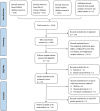Brain gray matter correlates of extraversion: A systematic review and meta-analysis of voxel-based morphometry studies
- PMID: 31169966
- PMCID: PMC6865809
- DOI: 10.1002/hbm.24684
Brain gray matter correlates of extraversion: A systematic review and meta-analysis of voxel-based morphometry studies
Abstract
Extraversion is a fundamental personality dimension closely related to an individual's life outcomes and mental health. Although an increasing number of studies have attempted to identify the neurostructural markers of extraversion, the results have been highly inconsistent. The current study aimed to achieve a comprehensive understanding of brain gray matter (GM) correlates of extraversion with a systematic review and meta-analysis approach. Our review showed relatively high interstudy heterogeneity among previous findings. Our meta-analysis of whole-brain voxel-based morphometry studies revealed that extraversion was stably associated with six core brain regions. Additionally, meta-regression analyses identified brain regions where the associations of extraversion with GM volume were modulated by gender and age. The relationships between extraversion and GM structures were discussed based on three extraversion-related functional systems. Furthermore, we explained the gender and age effects. Overall, our study is the first to reveal a comprehensive picture of brain GM correlates of extraversion, and the findings may be useful for the selection of targeted brain areas for extraversion interventions.
Keywords: extraversion; meta-analysis; structural magnetic resonance imaging; systematic review; voxel-based morphometry.
© 2019 Wiley Periodicals, Inc.
Conflict of interest statement
The authors declare no competing conflict of interest.
Figures





Similar articles
-
Gray matter structures associated with neuroticism: A meta-analysis of whole-brain voxel-based morphometry studies.Hum Brain Mapp. 2021 Jun 15;42(9):2706-2721. doi: 10.1002/hbm.25395. Epub 2021 Mar 11. Hum Brain Mapp. 2021. PMID: 33704850 Free PMC article.
-
Neurostructural correlates of optimism: Gray matter density in the putamen predicts dispositional optimism in late adolescence.Hum Brain Mapp. 2020 Apr 15;41(6):1459-1471. doi: 10.1002/hbm.24888. Epub 2019 Dec 9. Hum Brain Mapp. 2020. PMID: 31816149 Free PMC article.
-
Brain gray matter structures associated with trait impulsivity: A systematic review and voxel-based meta-analysis.Hum Brain Mapp. 2021 May;42(7):2214-2235. doi: 10.1002/hbm.25361. Epub 2021 Feb 18. Hum Brain Mapp. 2021. PMID: 33599347 Free PMC article.
-
Neuroanatomical correlates of extraversion: a test-retest study implicating gray matter volume in the caudate nucleus.Neuroreport. 2019 Oct 9;30(14):953-959. doi: 10.1097/WNR.0000000000001306. Neuroreport. 2019. PMID: 31469723
-
Increased Cerebellar Gray Matter Volume in Athletes: A Voxel-Wise Coordinate-Based Meta-Analysis.Res Q Exerc Sport. 2023 Sep;94(3):597-608. doi: 10.1080/02701367.2022.2026285. Epub 2022 Apr 19. Res Q Exerc Sport. 2023. PMID: 35438607
Cited by
-
Gray matter structures associated with neuroticism: A meta-analysis of whole-brain voxel-based morphometry studies.Hum Brain Mapp. 2021 Jun 15;42(9):2706-2721. doi: 10.1002/hbm.25395. Epub 2021 Mar 11. Hum Brain Mapp. 2021. PMID: 33704850 Free PMC article.
-
Association of loneliness and grey matter volume in the dorsolateral prefrontal cortex: the mediating role of interpersonal self-support traits.Brain Imaging Behav. 2023 Oct;17(5):481-493. doi: 10.1007/s11682-023-00776-4. Epub 2023 Jun 6. Brain Imaging Behav. 2023. PMID: 37277604
-
The Selective Dopamine D2 Blocker Sulpiride Modulates the Relationship Between Agentic Extraversion and Executive Functions.Cogn Affect Behav Neurosci. 2021 Aug;21(4):852-867. doi: 10.3758/s13415-021-00887-9. Epub 2021 Apr 2. Cogn Affect Behav Neurosci. 2021. PMID: 33811308 Free PMC article.
-
Neurostructural correlates of optimism: Gray matter density in the putamen predicts dispositional optimism in late adolescence.Hum Brain Mapp. 2020 Apr 15;41(6):1459-1471. doi: 10.1002/hbm.24888. Epub 2019 Dec 9. Hum Brain Mapp. 2020. PMID: 31816149 Free PMC article.
-
"Nothing to see here": No structural brain differences as a function of the Big Five personality traits from a systematic review and meta-analysis.Personal Neurosci. 2022 Aug 9;5:e8. doi: 10.1017/pen.2021.5. eCollection 2022. Personal Neurosci. 2022. PMID: 35991756 Free PMC article. Review.
References
-
- Andari, E. , Schneider, F. C. , Mottolese, R. , Vindras, P. , & Sirigu, A. (2014). Oxytocin's fingerprint in personality traits and regional brain volume. Cerebral Cortex, 24(2), 479–486. - PubMed
-
- Baik, S. H. , Yoon, H. S. , Kim, S. E. , & Kim, S. H. (2012). Extraversion and striatal dopaminergic receptor availability in young adults: An [18F]fallypride PET study. NeuroReport, 23(4), 251–254. - PubMed
-
- Benedict, R. H. , Hussein, S. , Englert, J. , Dwyer, M. G. , Abdelrahman, N. , Cox, J. L. , … Zivadinov, R. (2008). Cortical atrophy and personality in multiple sclerosis. Neuropsychology, 22(4), 432–441. - PubMed
Publication types
MeSH terms
Grants and funding
- F510000/G16916411/American CMB Distinguished Professorship Award/International
- T2014190/Changjiang Scholar Professorship Award of China/International
- 2019M653421/China Postdoctoral Science Foundation/International
- 81621003/National Natural Science Foundation of China/International
- 81820108018 and 31800963/National Natural Science Foundation of China/International
LinkOut - more resources
Full Text Sources

